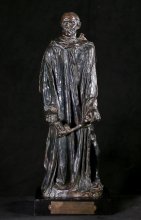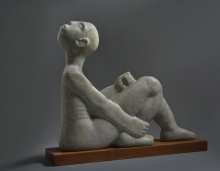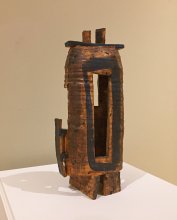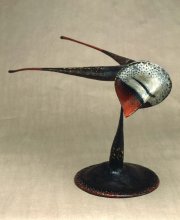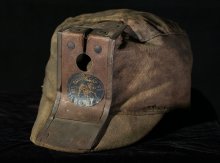Modern Era (1917-present)
The state’s Modern Era has been one of continued growth and change. Following World War I and the nation’s greatest economic collapse, public works projects of the New Deal put people to work on civic projects, such as building roads and infrastructure, and brought history to life by protecting a number of historic places around the state. The Federal Arts Program of the W.P.A. paid artists to create paintings, prints, sculptures, and murals for civic beautification, pride, and capturing the moment. Beginning in 1941, the state’s agricultural and manufacturing sectors and the sacrifices of citizen-soldiers played an important role in making the United States a leader on the world stage.
This sculpture was a gift to the people of the State of Illinois from French vermouth producer Noilly-Prat. This was one of many gifts packed into vintage railway box cars known as the Merci Train, or French Gratitude Train, of 1949. The purpose of this gift was to acknowledge the more than $40 million in food and aid collected in 1947 by private citizens in the United States and sent to France and Italy after World War II.
Miyoko Ito was an important artist in Chicago, admired by her contemporaries for her distinctive approach to painting. Her delicate, quick brush strokes and remarkable color combinations give her paintings a lively pulse. Ito was born to Japanese immigrant parents in Berkeley, California. She developed artistically under the influence of a wide range of movements and revolutions in the arts: Cubism, Bauhaus, Abstract Expressionism, and individual artists as diverse as Pablo Picasso, Hans Hoffman, and Paul Cezanne.
In 1916, at the age of 8, Marion Perkins moved from Arkansas to Chicago to live with his aunt, joining the ranks of over 500,000 African Americans who moved to Chicago from the south during a period now referred to as the Great Migration. He lived in Bronzeville, Chicago’s predominately African American neighborhood and home to many of its most outstanding writers and artists.
Moon House, created in 1957, clearly reveals Shrode’s full grasp of the fine art versus craft debate. Here, Shrode shapes the vessel form into fine art, showing the influences of Abstract Expressionism and Asian pottery techniques, while constructing innovative flowing relationships of positive form and negative space.
A monumental sculpture, this majestic horse commemorates the spirit of the people of the midwest. Named after the donors’ favorite horse, Kimball, the draft horse is a symbol of the strength and courage of the early settlers of Illinois and all who continue to work the land.
Mt. Vernon, Illinois, native Ivan Summers established himself in the early 20th century as one of the accomplished practitioners of American Impressionism with colorful landscapes of his adopted home of upstate New York. He graduated from the St. Louis School and Museum of Fine Arts where he was an award-winning artist.
Southern Illinois’ most well-known blacksmith-artist-teacher, Brent Kington (1934-2013), created unconventional works of art from blacksmithing for over 45 years while teaching at Southern Illinois University Carbondale.
Mining hats provided some protection from soot and dust, but their main function was to serve as a place to mount a lamp, which was essential for working underground. This hat would have had a carbide lamp attached to the metal piece over the bill. Carbide lamps burned more cleanly and brightly than oil lamps, although the open flames still posed a danger with the potential of igniting methane gas underground.
The Kirtland’s Water Snake shares some similar habitats and habits as the Massasauga Rattlesnake and is also under scrutiny as its numbers continue to decline. It is not venomous, but it uses crayfish burrows like the Massasauga and spends most of its life underground. Biologists hoping to survey the secretive snake often will use a cover board, a corrugated sheet of aluminum that is placed over a crayfish burrow.
The Eastern Massasauga Rattlesnake is a small, venomous snake recently listed as threatened by the U.S. Fish and Wildlife Service. It persists in only a few locations in Illinois, Indiana, Iowa, Michigan, New York, Ohio, Pennsylvania, and Wisconsin. The Fish and Wildlife Service describes the Massasauga as “a small snake with a thick body, heart-shaped head and vertical pupils.”
Pages






